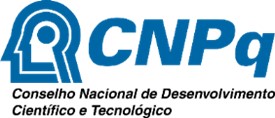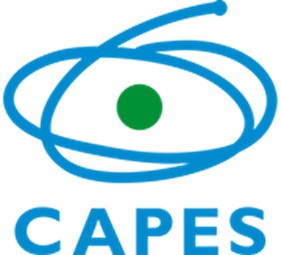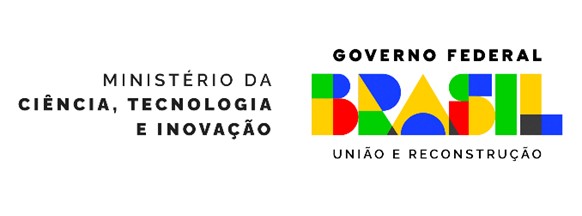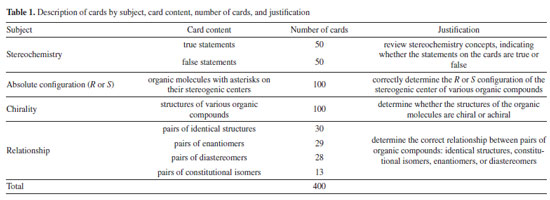Educação
| Design of an educational gam e and its use in a team game tournament as a strategy to engage students in reviewing stereochemistry concepts |
|
José Nunes da Silva JúniorI,* I. Departamento de Química Orgânica e Inorgânica, Universidade Federal do Ceará, 60451-970 Fortaleza -CE, Brasil Received: 10/31/2024 *e-mail: nunes.ufc@gmail.com This paper presents a Chemistry Team Game Tournament (TGT) as a didactic strategy to review stereochemistry concepts. For this purpose, a multilingual (English, Italian, French, and Portuguese) educational game, Stereochemistry Race, was developed on the online digital platform PlayingCards. The study involved the participation of 85 students from the following institutions: sixteen first-year Pharmacy students at the Federal University of Ceará (Brazil); twelve senior high school students at Colégio Maximus, in Fortaleza (Brazil); sixteen first-year Natural Sciences students and forty-one first-year Biotechnology students at the Università degli Studi di Genova (Italy). After the implementation of the tournament, the students evaluated the game, the match strategy, and their social and emotional interactions with their peers. To this end, data collection was carried out using a form that also included the UES-SF (User Engagement Scale-Short Form) engagement assessment model, which showed greater student participation and interest in stereochemistry studies than to traditional review classes. INTRODUCTION The study of the three-dimensional arrangement of atoms and molecules, known as stereochemistry, is fundamental to understanding the properties and reactivities of compounds. Its importance is highlighted in various fields, such as pharmaceutical chemistry, drug design, materials science, and organic synthesis. Stereochemistry is the foundation for understanding the structures of the fundamental building blocks that make up living organisms. These blocks include chiral compounds found in nature in enantiomerically pure forms, such as nucleotides, sugars, and α-amino acids.1 Different stereoisomers can exhibit variations in their biological activities, pharmacokinetic profiles, and mechanical properties, which directly affect their therapeutic effects. Stereochemistry plays a critical role in determining the structure, function, and activity of organic molecules, influencing their behavior in biological systems and chemical reactions. Mastery of this area by students is crucial for the pharmaceutical industry, as it helps avoid adverse effects caused by inactive or unsafe enantiomers present in racemic mixtures, ensuring greater safety and efficacy in drug development.2 However, stereochemistry is often considered a challenging discipline by many academics, primarily due to its complexity in three-dimensional visualization and the difficulty in assimilating fundamental concepts such as asymmetric carbon and chirality. These barriers may lead to unsatisfactory student performance and the development of misconceptions, hindering progress in various academic careers that rely on this knowledge.2-4 Therefore, since the 1940s, educators have sought different strategies to represent the positions of stereochemical groups on the plane of the blackboard, attempting to facilitate three-dimensional visualization. If these limitations are not overcome, academic and professional development in fields that require a solid understanding of stereochemistry, such as chemistry, biochemistry, and pharmacology, may be seriously impacted.5,6 In this context, educators and researchers in educational games have also dedicated themselves to studies demonstrating that games can be effective tools for presenting and representing concepts and promoting the learning process. This approach generally creates a more engaging classroom environment, increasing students' attention, encouraging interaction, and boosting learning motivation.3-13 Game-based learning and teaching theorists argue that games can positively impact education by providing an intrinsically motivating and engaging environment,14-16 capable of engaging students in ways that traditional methodology often fails to achieve. Among the main characteristics of GBL (Game Based Learning) is its ability to provide immersive and meaningful learning experiences. When well implemented, games used in this approach promote the development of essential skills, such as strategic thinking, decision-making, and collaborative problem-solving, that are indispensable for facing the challenges of the 21st century.15-17 In addition, GBL stands out for its flexibility, allowing it to be applied in various educational contexts. This approach is effective not only in introducing new content and reviewing concepts but also in assessing competencies, making it a comprehensive methodology that is fully aligned with the demands of contemporary education.14,15,18 Team Game Tournament Although there is a wide variety of educational games aimed at teaching chemistry, a notable activity was presented by JoAnn Paslawsky in 1976,7 which reviewed chemical concepts through a competitive tournament among students. In this way, students could accumulate extra points or revalidate final grades through a specific scoring system. This type of activity was called the Team Game Tournament (TGT). Since then, TGT has been proposed to address particular difficulties in learning chemistry, such as challenges in representing molecules and chemical concepts,7,8 balancing equations,9 organic synthesis,10 studying the periodic table,11 and organic acids and bases.12 TGT follows three main principles: (i) formation of homogeneous teams with proportional skill levels; (ii) rules, where students face challenges in qualifying and elimination phases; (iii) tournament, where students compete individually, but the results are combined to determine the winning team.19 As a tool for conducting TGT, specific categories of games, such as puzzles and flashcards,20,21 have proven effective as complementary resources during matches. Russell22 demonstrated that using flashcards in TGT attracts students to the study of chemistry, increasing focus on activities and knowledge retention. In parallel, educators have combined TGT with cooperative learning, promoting greater interaction between students and teachers.22 This combination contributes to the development of communication and collaboration skills, in addition to increasing engagement and improving content comprehension.21,22 Considering these characteristics, specific studies on cooperative learning in TGT indicate improvements in both academic performance and students' attitudes toward the subjects.20 Thus, TGT, due to its interactive and collaborative nature, promotes teamwork and can also be considered a promising strategy to facilitate the intuitive understanding of stereochemical concepts, including allowing students to manipulate three-dimensional representations of molecules, making it easier to comprehend the necessary concepts.22-24 However, although this type of playful activity has been widely applied in various areas, including chemistry, no research specifically aimed at teaching stereochemistry has been identified.12,25,26 Based on this context, this article presents the design of an educational game named Stereochemistry Race and its implementation in a TGT as a didactic strategy that allows students to review concepts related to Stereochemistry, which were taught in the classroom.
METHODOLOGY Description of Stereochemistry Race game The Stereochemistry Race was developed and hosted on the online platform PlayingCards27-30 and is available in digital format in English,27 Portuguese,28 French,29 and Italian.30 Figure 1 shows the QR codes with direct access links to the game in the respective languages mentioned. Created to review stereochemistry content, the Stereochemistry Race is designed for high school and undergraduate students. It can be played either in-person or remotely on computers and mobile devices. For remote play, the parallel use of communication platforms such as WhatsApp, Google Meet, Zoom, or Microsoft Teams is recommended to facilitate interaction among participants and monitoring by the mediator or professor.
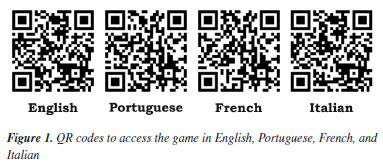
By scanning the QR code corresponding to the game in the selected language, the player is directed to a website where they will find the game rules and a "Start Game" button, which opens a virtual room when clicked. This room provides a code that must be shared with other players who will participate in the same game session. Only one player from the group needs to access the game and share the room code with their peers. The game is structured on a board, as illustrated in Figure 2, and has the following components in its interface: four pins representing the maximum number of players; a button to randomly select the player who will start the game (Figure 2a); a button to shuffle the cards from each deck (Figure 2b); a mechanism to move a card from the left deck to the right (Figure 2c); a button to reveal the answer of the moved card (Figure 2d); a "try your luck" option (Figure 2e); a reset button to restart the game (Figure 2f); and the finish line, marking the end of the game (Figure 2g).
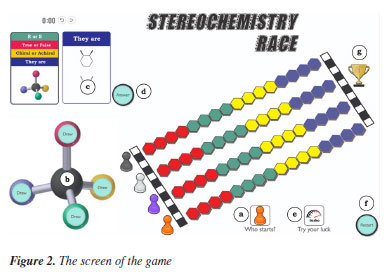
The deck is composed of 400 cards of four types, covering the following stereochemistry topics (Table 1):
True or False: 100 cards present statements on stereochemistry concepts for students to classify as true or false. Absolute configuration (R or S): 100 cards present structures of organic compounds with tetrahedral stereogenic centers marked with an asterisk for students to determine their absolute configuration. Chirality: 100 cards present organic compound structures for students to determine whether they are chiral or achiral. Relationship: 100 cards present pairs of structures of organic compounds for students to classify as identical, constitutional isomers, enantiomers, or diastereomers. The contents covered on the cards were the same as taught in the classroom, and the card decks were designed to induce reflection and conceptual discussion, aligning with educational game theories, emphasizing the importance of intrinsic engagement and motivation for learning.13,16,18 Fun and engagement are central elements of the game, and the questions were designed to promote not only the review of concepts but also interaction and collaboration among participants. Figure 3 presents examples of the four types of cards. The game uses two dice, as illustrated in Figure 4. Die 1 determines the first player, while Die 2 defines "try your luck" actions that can be used during the game. Some of these possible actions include "skip turn" (Figure 4a), "turbo" (Figure 4b), and "box" (Figure 4c).
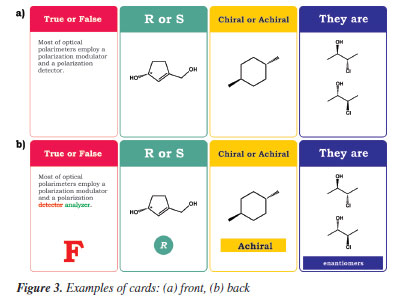
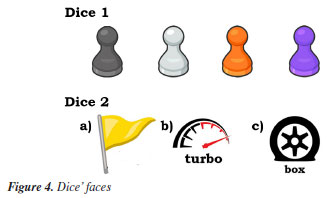
Game rules The game can be played by 2 to 4 players. Each player must select a colored game piece of their choice. Each player must follow their trail, which is made up of 16 squares, composed of 4 different colored sections, with specific tasks:
To travel along the trail, the player must correctly execute the above commands until reaching the trail's end. The one who completes their entire trail first, reaching the area where the trophy is on the board (Figure 2g), becomes the champion. Playing the game
Implementation of Team Game Tournaments Initially, sixteen Brazilian first-year Pharmacy undergraduate students (three males and thirteen females) from the Federal University of Ceará in Brazil participated in the tournament in April 2024. The TGT was held in person in two consecutive classes within the classroom after students had attended five lectures (2 hours each) on stereochemistry (Figure 5).
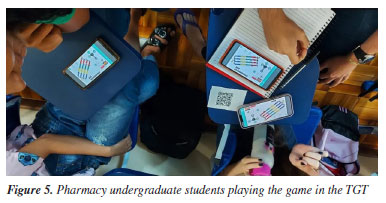
Firstly, we sorted out the 16 students in descending order of performances in previous exams in the course. So, we set up four sub-groups (A-D) with one student from each group, ensuring that the sub-groups were internally homogeneous and of similar levels. Next, students from sub-groups (A-D) participated in Round 1 of the Stereochemistry Race to determine their positions (A1, A2, A3, A4... B1, B2, B3, B4... C1, C2, C3, C4... D1, D2, D3, D4) within each group based on their performance in the game. After this first class, students could play the Stereochemistry Race at home to prepare for the next round. Round 2 was played during the next class where the first-place players (A1, B1, C1, D1….A2, B2, C2, D2… A3, B3, C3, D3… A4, B4, C4, D4) in each group played against each other. The same thing happened with second, third, and fourth places. In Round 2, players won 25 points (first place), 18 points (second place), and 12 points (third place). The last ones did not get any points. Finally, the scores achieved by each student were added up, totaling the points of the sub-groups and defining who the tournament champion was. Figure 6 summarizes the TGT process.
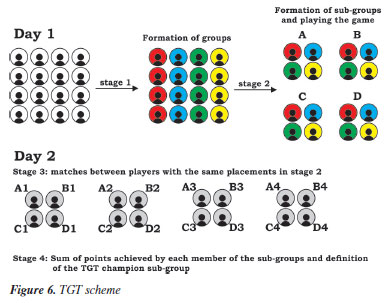
The time spent in Round 1 (game matches held between members of each sub-group) ranged from 37 to 66 minutes (58 on average), and the time spent in Round 2 (game matches held between members of sub-groups) ranged from 35 to 41 minutes (37 on average). The lower time spent in Round 2 was due to an agreement between the students, who established a maximum time of 40 seconds to answer the questions. In April 2024, we repeated the TGT process with twelve high school 12th-grade students (four males and eight females) from Colégio Maximus in Fortaleza, Brazil. They spent 35 minutes on average in Round 1 and 45 minutes on average in Round 2. In May 2024, at the Università degli Studi di Genova, in Italy, sixteen first-year Natural Science undergraduate students and forty-one first-year Biotechnology students also participated in the TGT. The Italian students spent about 50 minutes in both rounds. Evaluation process This study has a mixed descriptive nature, both quantitative and qualitative, allowing for an in-depth investigation of stereochemical concepts and representations.31 Such an approach, combined with exploratory and confirmatory aspects, brings the researcher closer to the object of study, being used to identify and analyze relevant variables that may influence the results, promoting a rigorous statistical analysis.31,32 Combining these techniques generates insights that can contribute to using TGT in teaching stereochemistry as a complementary strategy. Moreover, adopting the appropriate analytical tools ensures the validity and reliability of the data obtained, strengthening the study's conclusions. Data collection and analysis techniques An electronic form was used to evaluate the game and the tournament. It has adopted a five-point Likert scale ranging from "strongly agree" to "strongly disagree", followed by subjective questions. Additionally, the UES-SF scale (User Engagement Scale-Short Form) was employed to measure student engagement and behavior toward the tournament and their emotional interactions.33 The choice of this scale was due to its ability to objectively and concisely assess the level of engagement between humans and technology (familiarity with technologies), offering a comprehensive analysis of the experience within the educational context.25,26 Using a widely validated scale such as the UES-SF also strengthens the research, broadening the validation evidence and ensuring greater robustness and credibility to the results obtained. The form was divided into three sections (see Table 1S of the Supplementary Material). The first section presented students with ten statements (GS1-GS10) related to the graphical interface, content, and usefulness of the game, as well as two open-ended questions (GS11-GS12) about the positive and negative aspects of the game, and a rating from 0 to 10 for the game (GS13). In the second section, the TGT strategy was evaluated through eight questions (TS1-TS8), followed by two open-ended questions (TS9-TS10) regarding the positive and negative aspects of the TGT rounds, as well as a rating from 0 to 10 (TS11) for the tournament as a strategy for reviewing stereochemistry concepts. Finally, the third section included twelve questions to measure user engagement in the TGT using the UES-SF scale.
RESULTS AND DISCUSSION The students' data is protected by the General Data Protection Law (LGPD) - Law No. 13.709/18, as provided in Article 7, Section I, expressed freely and unequivocally.34 Of the 85 students involved in this methodological investigation, two Brazilian university students did not complete the evaluation form, and therefore, their data was not included, as shown in Table 2.
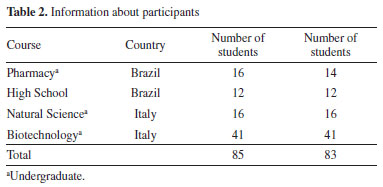
During the application of the game, it was observed that the concepts of absolute configuration (R/S) and optical isomerism were the most discussed among the students. The participants demonstrated greater difficulty in questions related to the nomenclature of chiral compounds, while the cards about molecular symmetry questions had a higher rate of correct answers. These observations suggest that the game not only engaged the students but also promoted the review and active discussion of stereochemistry concepts, indicating a potential impact on learning, as we can identify from the students' oral feedback below. "A great tool for memorizing content, through interactive questions that are fun and good for reviewing." "The questions cover the content in a great way." "It covers the entire subject; it is practical for reviewing the content." "Many cards, which allow the student to practice different compounds, help to retain the content more interestingly and interactively." "Easy to play, cards that cover the subject's content well, and you can choose to depend on luck by rolling the dice or just going with the correct answers." "The game is very fun and allows you to understand what you have really learned and what you are having difficulty with." "The game promotes cooperation and teamwork while reviewing the content covered in the cards." "It explores many styles of questions that can be asked on exams." "It helps students review stereochemistry and the aspect of working under ‘pressure'." Figures 7 and 8 present the results of the students' evaluation of the game and the TGT strategy, respectively. Based on the collected data, we used a Likert-based assessment technique to analyze the effectiveness, applicability, and engagement level of the game and the TGT.
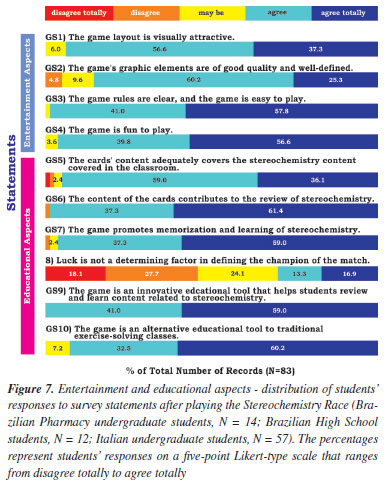
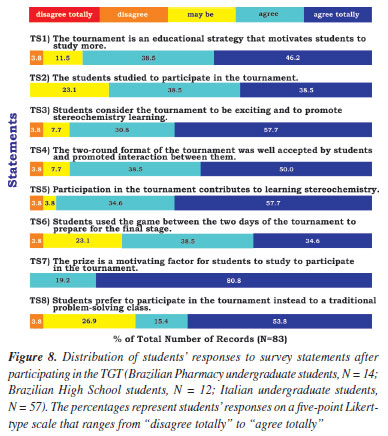
Evaluating the game Through the electronic form, we asked students to identify the positive and negative aspects (GS11-GS12, Tables 1S to 4S of the Supplementary Material) of the game "Stereochemistry Race", conducting a qualitative analysis. Of the 83 students who responded, 74 left positive comments, and 12 mentioned negative aspects. These comments were organized according to their frequencies in Tables 3 and 4.
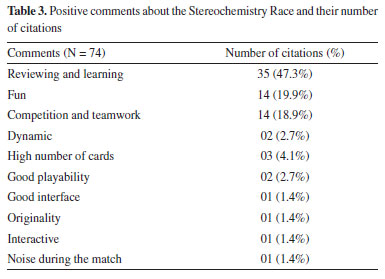
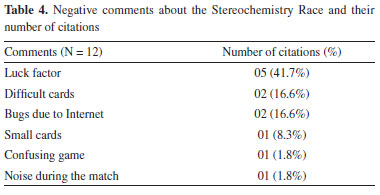
Based on the students' comments, it can be concluded that the game proved to be an effective and dynamic educational tool for reviewing stereochemistry concepts in a playful manner. The positive aspects mentioned were the number of cards, gameplay, intuitive interface, originality, and game interactivity. Additionally, its structure encourages both teamwork and healthy competition among participants. Among the negative points mentioned by the students, the element of luck was the most cited, However, it is an inherent aspect of any game, including the different rounds of TGT. Two students pointed out the size of the cards as an issue; however, as previously highlighted, increasing the size can be quickly done by holding down the card on mobile devices or hovering the cursor over it on computers. Two students also reported technical issues caused by internet connection problems, which are external to the game, and only one respondent considered the game confusing. Evaluating the TGT Figure 8 represents the analysis of the data collected in Section 2 (see Table 1S, and Tables 5S to 7S of the Supplementary Material). Based on the students' responses, the tournament (TS3) was exciting and promoted the review of stereochemistry concepts. The tournament format was well received (TS4), and the students considered this educational strategy motivating, encouraging them to study the content more frequently (TS1 and TS2). They believe that teaching strategies such as the tournament contribute to their learning in stereochemistry (TS5). The additional points offered as prizes were a motivating factor, encouraging them to review the content to participate in the tournament (TS7). In addition, considering that the students could play the Stereochemistry Race between the two days of the event, they agreed that this practice helped them better prepare for Round 2 (TS6). Lastly, a significant percentage (53.0%) of the students preferred participating in the tournament over a traditional problem-solving class (TS8). These results make us believe that the game and the tournament reached their goal of engaging students in reviewing stereochemistry. Evaluating the students' engagement in TGT "User engagement" is a central aspect of user experience, representing the degree of involvement of an individual when interacting with a digital resource. In recent years, measuring this engagement has sparked increasing interest in human-computer interaction, especially in educational systems. To understand how the tournament promoted engagement and interest in participation, we invited students to answer the questions proposed in the electronic form UES-SF.35 This scale is a tool composed of twelve questions divided into four domains, which consider how people use (PU) and regard the visual aspect of the system (AE), analyze participant concentration within the system (FA), and measure interaction, curiosity, interest, and perceived involvement in the experience (RW). Figure 9 shows the overall engagement from each domain obtained from all the students who participated in the tournaments (see Table 8S and Figures 4S and 5S of the Supplementary Material). The overall engagement UES-SF score was 4.25 ± 0.27 (the closer to 5, the greater the engagement). Therefore, we can conclude that the TGT engaged the students in reviewing the concepts related to stereochemistry.
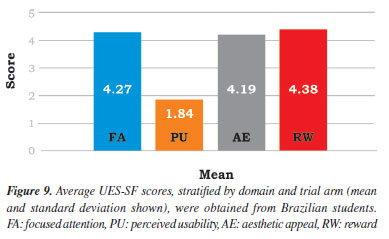
Based on these results, the activity presented in this article offers an alternative to traditional problem-solving classes for reviewing stereochemistry content covered in the classroom. Students positively evaluated the strategy applied in the TGT as effective in increasing their motivation and helping them review concepts, highlighting the Stereochemistry Race as a valuable educational tool in this process.
CONCLUSIONS The traditional method of lectures and assignments, widely used for reviewing chemistry content, is often perceived by students as tedious. Many students end up merely copying the solutions teachers provide, which limits active engagement and comprehension of the material. The Team Game Tournament presented in this study offers an effective alternative for reviewing stereochemistry concepts. This dynamic and interactive approach provides a more engaging and enjoyable learning experience, encouraging students to participate more actively. The social and cooperative nature of the TGT also facilitates instant feedback and clarification of doubts during the rounds. The results indicate that the activity presented in this article offers an effective alternative to traditional problem-solving classes for reviewing stereochemistry content. Students positively evaluated the strategy applied in the TGT, highlighting its impact on motivation and concept review and considering the Stereochemistry Race a valuable educational tool in this process. In addition to promoting communication and cooperation among students, the TGT was well received by participants and proved to be a promising approach to complement traditional methods, providing a more dynamic and interactive learning environment. The TGT stands out from other educational approaches by combining healthy competition with cooperation, fostering teamwork and knowledge exchange. Its turn-based structure promotes gradual and continuous learning, allowing students to review concepts in a practical and strategic manner. The flexibility of the format enables its adaptation to different educational contexts, covering both high school and undergraduate levels and fostering a more engaging and effective learning environment. Although this study did not include a formal assessment of learning, it was observed that the game promoted active discussion of concepts such as chirality, absolute configuration, and isomerism. Future studies may include formal pre- and post-game assessments to measure the direct impact on learning of stereochemistry concepts.
SUPPLEMENTARY MATERIAL Complementary material for this work, including game rules in Portuguese, French, Italian, and surveys, is available at http://quimicanova.sbq.org.br/, as a PDF file, with free access.
ACKNOWLEDGMENT The authors acknowledge Mr. Rob Middleton from PlayingCards.io LLC for all the support in designing the Stereochemistry Race.
AUTHOR CONTRIBUTIONS José Nunes da Silva Júnior: project administration, management and coordination responsibility for the research activity planning and execution; Antonio José Melo Leite Junior, project administration, management and coordination responsibility for the research activity planning and execution; Renner César Silveira Jucá, data curation, formal analysis and investigation; Jean-Yves Winum, investigation and methodology; Andrea Basso, investigation and methodology; Chiara Lambruschini, investigation and methodology; Lara Bianchi, investigation and methodology; Lisa Moni, investigation and methodology; Maria do Socorro Caldas Teotônio, conceptualization and writing review and editing.
REFERENCES 1. Anslyn, E. V.; Dougherty, D. A.; Modern Physical Organic Chemistry; University Science Books: Sausalito, CA, USA, 2006. 2. Orlando, R. M.; Revista Eletrônica de Farmácia 2007, 4, 8. [Crossref] 3. Gilbert, J. K. In Visualization in Science Education, vol. 1; Gilbert, J. K., ed.; Springer: Dordrecht, 2005, p. 9. [Crossref] 4. Lyon, G. L.: College Students' Understanding of Stereochemistry: Difficulties in Learning and Critical Junctures; PhD Thesis, Louisiana State University and Agricultural & Mechanical College ProQuest Dissertations & Theses, 1999. [Link] accessed in April 2025 5. Fromm, F.; J. Chem. Educ. 1945, 22, 98. [Crossref] 6. Shine, H. J.; J. Chem. Educ. 1957, 34, 355. [Crossref] 7. Paslawsky, J.; J. Chem. Educ. 1976, 53, 780. [Crossref] 8. Alexander, S. V.; Sevcik, R. S.; Hicks, O.; Schultz, L. D.; J. Chem. Educ. 2008, 85, 514. [Crossref] 9. Schmitt, H.; J. Chem. Educ. 1976, 53, 172. [Crossref] 10. Smith, S. G.; Chabay, R.; J. Chem. Educ. 1977, 54, 688. [Crossref] 11. Franco-Mariscal, A. J.; Educación Química 2014, 25, 276. [Crossref] 12. da Silva Júnior, J. N.; Zampieri, D.; Leite Junior, A. J. M.; Alexandre, F. S. O.; Winum, J.-Y.; Basso, A.; Monteiro, A. J.; da Silva, L. L.; J. Chem. Educ. 2022, 99, 2190. [Crossref] 13. Prensky, M.; Computers in Entertainment 2003, 1, 21. [Crossref] 14. Dempsey, J. V.; Lucassen, B. A.; Haynes, L. L.; Casey, M. S.; Annual Meeting of the American Educational Research Association; New York, 1996. [Link] accessed in April 2025 15. Perucia, A. S.; Berthêm, A. C.; Bertschinger, G. L.; Menezes, R. R. C.; Desenvolvimento de Jogos Eletrônicos: Teoria e Prática; Novatec Editora: São Paulo, 2005. [Link] accessed in April 2025 16. Garris, R.; Ahlers, R. H.; Driskell, J. E.; Simulation & Gaming 2002, 33, 441. [Crossref] 17. Malone, T.; Cogn. Sci. 1981, 5, 333. [Crossref] 18. Gee, J. P.; Computers in Entertainment 2003, 1, 20. [Crossref] 19. Ke, F.; Grabowski, B.; British Journal of Educational Technology 2007, 38, 249. [Crossref] 20. Revell, K. D.; J. Chem. Educ. 2014, 91, 48. [Crossref] 21. Liberatore, M. W.; Chem. Eng. Educ. 2011, 45, 184. [Link] accessed in April 2025 22. Russell, J. V.; J. Chem. Educ. 1999, 76, 487. [Crossref] 23. Farmer, S. C.; Schuman, M. K.; J. Chem. Educ. 2016, 93, 695. [Crossref] 24. Nurwulandari, I.; Gunarhadi; Fadhilah, S. S.; International Journal of Recent Engineering Science (IJRES) 2017, 4, 29 [Link] accessed in April 2025 25. da Silva Júnior, J. N.; Leite, A. J. M.; Winum, J.-Y.; Basso, A.; de Sousa, U. S.; do Nascimento, D. M.; Alves, S. M.; Education for Chemical Engineers 2021, 36, 90. [Crossref] 26. da Silva Júnior, J. N.; Lima, M. A. S.; Miranda, F. N.; Leite Junior, A. J. M.; Alexandre, F. S. O.; Assis, D. C. O.; Nobre, D. J.; J. Chem. Educ. 2018, 95, 2055. [Crossref] 27. Stereochemistry Race - English on PlayingCards.io, https://playingcards.io/game/stereorace-en, accessed in April 2025. 28. Stereochemistry Race - Portuguese on PlayingCards.io, https://playingcards.io/game/stereorace-pt, accessed in April 2025. 29. Stereochemistry Race - French on PlayingCards.io, https://playingcards.io/game/stereorace-fr, accessed in April 2025. 30. Stereochemistry Race - Italian on PlayingCards.io, https://playingcards.io/game/stereorace-it, accessed in April 2025. 31. Creswell, J. W.; Research Design: Qualitative, Quantitative, and Mixed Methods Approaches, 3rd ed.; Sage Publications, Inc.: Thousand Oaks, CA, USA, 2009. 32. Magalhães Junior, C. A. O.; Batista, M. C.; Metodologia da Pesquisa em Educação e Ensino de Ciências, 1ª ed.; Gráfica e Editora Massoni: Maringá, PR, 2021. 33. O'Brien, H. In Why Engagement Matters; O'Brien, H.; Cairns, P., eds.; Springer: Cham, 2016, p. 1. [Crossref] 34. Lei Geral de Proteção de Dados Pessoais (LGPD), www.planalto.gov.br/ccivil_03/_ato2015-2018/2018/lei/l13709.htm, accessed in April 2025. 35. O'Brien, H. L.; Cairns, P.; Hall, M.; International Journal of Human-Computer Studies 2018, 112, 28. [Crossref]
Associate Editor handled this article: Nyuara A. S. Mesquita |
On-line version ISSN 1678-7064 Printed version ISSN 0100-4042
Qu�mica Nova
Publica��es da Sociedade Brasileira de Qu�mica
Caixa Postal: 26037
05513-970 S�o Paulo - SP
Tel/Fax: +55.11.3032.2299/+55.11.3814.3602
Free access

